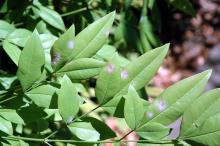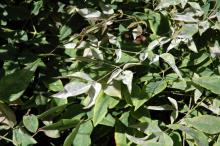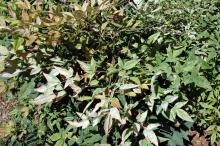See:
Oregon Grape (Mahonia aquifolium) - Powdery Mildew
Cause The fungus Erysiphe berberidis (formerly Microsphaera berberidis) was first documented in the Pacific Northwest in 2000 occurring on several diseased plants in western Washington. The pathogen has been found in Oregon and California. This fungus is an obligate parasite that favors shady, humid environments. An infected plant at WSU exhibited unsightly mildew symptoms for three years, yet tolerated the symptoms with no obvious signs of decline. Although powdery mildews are often host specific, E. berberidis is also known to target Oregon grape (Mahonia aquifolium).
Symptoms The most common sign of this disease is a white powdery fungal growth on the upper surface of leaves. It may be observed in either distinct patches or covering the entire leaf surface. The fungal growth can easily be removed by wiping the surface. The powder is composed of mycelium, conidiogenous structures, and conidia. Infected leaves tend to be smaller, curled and may appear more reddish in color relative to unaffected leaves (heavenly bamboo normally exhibits some red coloration). Many leaves may become infected on an individual plant.
Cultural control
- Plants should be planted in full sun.
- Plant with adequate spacing allow for good air circulation.
- If feasible, wipe leaves with wet cloth to remove fungus.
- Remove and destroy fallen leaves.
Chemical control Fungicides will do best when used before symptoms develop. Few materials have good eradicant activity. Use at 7- to 14-day intervals; using shorter intervals when environmental conditions favor disease development. Alternate or tank-mix products from different groups that have different modes of action.
- Broadform at 2 to 4 fl oz/100 gal water. Group 7 + 11 fungicide. 12-hr reentry.
- Heritage at 1 to 4 oz/100 gal water plus a non-silicone-based wetter sticker. Group 11 fungicide. 4-hr reentry.
- Insignia SC at 3 to 6 fl oz/100 gal water. Do not use with organosilicate-based adjuvants. Use preventively only. Group 11 fungicide. 12-hr reentry.
- Pageant at 6 to 12 oz/100 gal water. Do not use with organosilicone-based adjuvants. Group 7 + 11 fungicide. 12-hr reentry.
- Seido at 4 to 5 fl oz/100 gal water plus an adjuvant. Group 50 fungicide. 4-hr reentry.
- Terraguard SC at 4 to 8 fl oz/100 gal water. Group 3 fungicide. 12-hr reentry.
- Trinity at 4 to 12 fl oz/100 gal water. Group 3 fungicide. 12-hr reentry.
Reference Glawe, D.A. 2003. First report of powdery mildew of Nandina domestica caused by Microsphaera berberidis in the Pacific Northwest. Plant Health Progress doi: 10.1094/PHP-2003-1023-01-HN.




